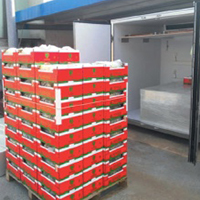Shipping container equipped with controlled atmosphere: Case study on table grape

Published: 16 March 2020
Abstract Views: 1717
PDF: 727
HTML: 297
HTML: 297
Publisher's note
All claims expressed in this article are solely those of the authors and do not necessarily represent those of their affiliated organizations, or those of the publisher, the editors and the reviewers. Any product that may be evaluated in this article or claim that may be made by its manufacturer is not guaranteed or endorsed by the publisher.
All claims expressed in this article are solely those of the authors and do not necessarily represent those of their affiliated organizations, or those of the publisher, the editors and the reviewers. Any product that may be evaluated in this article or claim that may be made by its manufacturer is not guaranteed or endorsed by the publisher.
Similar Articles
- Michela Zanetti, Benoît Brandelet, Diletta Marini, Andrea Sgarbossa, Chiara Giorio, Denis Badocco, Andrea Tapparo, Stefano Grigolato, Caroline Rogaume, Yann Rogaume, Raffaele Cavalli, Vineyard pruning residues pellets for use in domestic appliances: a quality assessment according to the EN ISO 17225 , Journal of Agricultural Engineering: Vol. 48 No. 2 (2017)
- Igor Kovacev, Daniele De Wrachien, Report on the 45th International Symposium: Actual Tasks on Agricultural Engineering, 21st-24th February 2017, Opatija, Croatia , Journal of Agricultural Engineering: Vol. 48 No. 2 (2017)
- Ciro Apollonio, Andrea Petroselli, Paolo Cornelini, Vito Manzari, Federico Preti, Salvatore Grimaldi, Riparian vegetation as a marker for bankfull and management discharge evaluation: The case study of Rio Torbido river basin (central Italy) , Journal of Agricultural Engineering: Vol. 52 No. 2 (2021)
- Valentina Giovenzana, Stefano Baroffio, Roberto Beghi, Andrea Casson, Alessia Pampuri, Alessio Tugnolo, Diego De Filippi, Riccardo Guidetti, Technological innovation in the winery addressing oenology 4.0: testing of an automated system for the alcoholic fermentation management , Journal of Agricultural Engineering: Vol. 52 No. 4 (2021)
- Alex Otieno Owino, Najmun Nahar, Zakaria Hossain, Noma Tamaki, Effects of basalt fibres on strength and permeability of rice husk ash-treated expansive soils , Journal of Agricultural Engineering: Vol. 53 No. 1 (2022)
- Lingxin Bu, Qianwen Kou, Adilet Sugirbay, Jun Chen, Yu Chen, An air-assisted mechanical hill-seeding device for foxtail millet (Setaria italica) , Journal of Agricultural Engineering: Vol. 55 No. 2 (2024)
- Marco Manzone, Gianfranco Airoldi, Angela Calvo, Transportation of maize silage to biogas plants , Journal of Agricultural Engineering: Vol. 51 No. 2 (2020)
- Zhongju Wang, Chao Huang, Long Wang, Parameter estimation of soil water retention curve with Rao-1 algorithm , Journal of Agricultural Engineering: Vol. 53 No. 2 (2022)
- Vidas Damanauskas, Algirdas Janulevičius, Effect of tillage implement (spring tine cultivator, disc harrow), soil texture, forward speed, and tillage depth on fuel consumption and tillage quality , Journal of Agricultural Engineering: Vol. 53 No. 3 (2022)
- Aristide Timene, Haman Djalo, Design of a five-bar duckbill-type mechanism for sorghum transplanting , Journal of Agricultural Engineering: Vol. 54 No. 2 (2023)
<< < 18 19 20 21 22 23 24 25 26 27 > >>
You may also start an advanced similarity search for this article.

 https://doi.org/10.4081/jae.2020.954
https://doi.org/10.4081/jae.2020.954






